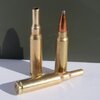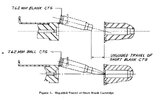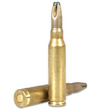Durango_Dave
Member
My Dad was recently buried at a military funeral. A 21 gun salute was performed and they gave the spent shells to family members.
These were no ordinary blanks. They seem to be similar to 7.62×51 but the tip, where the bullet would normally be had a long snoot with a plug in it.
Looking over these shells I realized the rifles could not shoot regular 7.62 ammo. A bullet would prevent the round from chambering.

If these blanks were ever used in a normal rifle chambered in 7.62×51 the "snoot" at the end would rupture under pressure. The rifles must have been modified to only shoot these special blanks. I'm sure this was done for safety reasons. The guns could never be loaded with anything more dangerous than blanks.
To my surprise one of the blanks they gave us was unfired. You can see the primer in the picture. There is a red plug a tenth of an inch down the snoot.
I'm posting this just in case someone has more information about these specialized guns. This seems like something Ian McCollum from FogottenWeapons.com would have a video on but I couldn't find one.
Note about my picture: I don't have a 7.62x51 cartridge so I used a .300 Savage for comparison. The only difference is the .300 Savage has a slightly shorter neck and steeper shoulder.
Thanks in advance for your condolences but Dad was 97 years old, bedridden and in pain. It was good when his suffering was over.
EDIT: this wasn't really a 21 gun salute. Since this was a funeral it was a three-volley salute.
These were no ordinary blanks. They seem to be similar to 7.62×51 but the tip, where the bullet would normally be had a long snoot with a plug in it.
Looking over these shells I realized the rifles could not shoot regular 7.62 ammo. A bullet would prevent the round from chambering.

If these blanks were ever used in a normal rifle chambered in 7.62×51 the "snoot" at the end would rupture under pressure. The rifles must have been modified to only shoot these special blanks. I'm sure this was done for safety reasons. The guns could never be loaded with anything more dangerous than blanks.
To my surprise one of the blanks they gave us was unfired. You can see the primer in the picture. There is a red plug a tenth of an inch down the snoot.
I'm posting this just in case someone has more information about these specialized guns. This seems like something Ian McCollum from FogottenWeapons.com would have a video on but I couldn't find one.
Note about my picture: I don't have a 7.62x51 cartridge so I used a .300 Savage for comparison. The only difference is the .300 Savage has a slightly shorter neck and steeper shoulder.
Thanks in advance for your condolences but Dad was 97 years old, bedridden and in pain. It was good when his suffering was over.
EDIT: this wasn't really a 21 gun salute. Since this was a funeral it was a three-volley salute.
Last edited:



